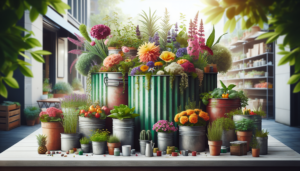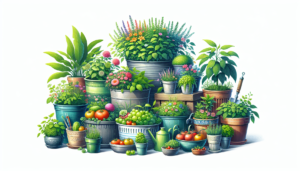
If you’ve ever dreamed of having a lush and vibrant garden but are faced with the challenge of gardening on a slope, fear not! This article is here to share some valuable tips on successful container gardening on a slope. Whether you have a small balcony or a sprawling backyard, these tips will help you turn any sloping terrain into a beautiful and thriving container garden. From choosing the right containers to selecting the perfect plants, we’ve got you covered. So grab your gardening gloves and join us as we explore the wonderful world of container gardening on a slope.
Choosing the Right Containers
When it comes to container gardening on a slope, it’s important to choose the right containers for the job. Consider the size and material of the containers you will be using. Larger containers can hold more soil, which helps with water retention and stability. Additionally, containers made of lightweight materials such as plastic or fiberglass are easier to maneuver on a slope.
Another crucial factor to consider is proper drainage. Ensure that the containers have proper drainage holes at the bottom to prevent waterlogging. Excess water can be detrimental to the health of your plants, leading to root rot and other issues. If the containers you choose don’t have drainage holes, make sure to drill some before planting.
Opting for containers with a wider base is advisable for gardening on a slope. The wider base provides stability, reducing the risk of the containers tipping over when exposed to wind or rain. Additionally, wider-based containers are less likely to roll or slide down the slope, keeping your plants securely in place.
Lastly, consider the weight and stability of the containers themselves. If your slope is particularly steep, you may want to select containers that are heavier or have a lower center of gravity to prevent them from toppling over. Alternatively, you can anchor the containers to the ground using stakes or other means to provide extra stability.
Selecting the Right Plants for a Slope
Choosing the right plants is crucial when it comes to successfully gardening on a slope. The unique conditions of a slope, such as increased water runoff, can make it challenging for some plants to thrive. Here are some considerations to keep in mind:
First and foremost, select plants that can withstand slope conditions. Look for plants that are known to grow well in challenging environments and are capable of withstanding heavy rains or drought. Native plants are often a great choice as they are well-adapted to the local climate and soil conditions.
Deep-rooted plants are highly recommended for sloping gardens as their extensive root systems help anchor the plants and prevent erosion. These plants are better equipped to withstand heavy rains by holding onto the soil, reducing the risk of soil runoff and erosion.
Low-maintenance plants are also ideal for container gardening on a slope. Since accessing the containers and plants may require some effort, it’s best to choose plants that require minimal care and attention. Look for plants that have a reputation for being hardy and self-sufficient.
Additionally, consider selecting plants that provide erosion control. These plants not only beautify your slope but also serve the important purpose of stabilizing the soil. Groundcovers, such as creeping thyme or English ivy, can form a dense mat that helps prevent soil erosion and runoff.
Preparing the Slope for Container Gardening
Before you start planting, it’s essential to prepare the slope properly. Follow these steps to ensure a successful container garden on a slope:
Begin by clearing the area of any debris or vegetation. Remove any rocks, weeds, or other obstacles that may impede the growth of your plants. This will create a clean slate for your container garden.
If your slope is uneven or too steep, consider leveling it and building terraces. Terracing involves creating multiple flat areas or steps on the slope to provide a more stable and manageable planting surface. Not only does this help with soil erosion control, but it also allows for better organization and accessibility.
To improve soil quality, add compost or organic matter to the planting area. This will enhance moisture retention, provide essential nutrients, and ensure healthier plant growth. Incorporating organic matter also helps with soil structure and drainage, both of which are important for container gardening success.
Consider installing a retaining wall or using rockeries to prevent soil erosion. Retaining walls can be made of stone, wood, or other materials and help hold the soil in place, giving your plants a stable foundation. Rockeries, which involve arranging rocks in a decorative manner, can also act as a barrier to prevent soil runoff and add visual interest to your slope.
Proper Watering Techniques
Watering your container garden correctly is crucial for the overall health and success of your plants. Follow these tips for successful watering on a slope:
Water deeply but infrequently. This allows the water to penetrate deeply into the soil, promoting healthy root growth. Frequent, shallow watering can lead to shallow root development and make your plants more susceptible to stress and drought.
Consider using a drip irrigation system or soaker hoses. These methods deliver water directly to the base of the plants, reducing water wastage and ensuring efficient watering. They also help keep the foliage dry, which can help prevent plant diseases.
Avoid overwatering or allowing water to stagnate in the containers. Excess moisture can lead to root rot and other fungal diseases, which can be detrimental to your plants’ health. Always let the soil dry out slightly between waterings to prevent waterlogged roots.
Water your plants in the early morning or late afternoon to reduce evaporation. Watering during the hottest part of the day can result in water loss due to evaporation before plants can absorb it. Morning or late afternoon watering allows the plants to take up the water more effectively and reduces water waste.
Choosing the Right Soil Mix
The soil you use in your containers plays a vital role in the overall health and success of your plants. Here are some tips for selecting the right soil mix for your container gardening on a slope:
Choose well-draining soil to prevent waterlogged roots. Excess moisture can lead to root rot and other problems, so it’s crucial to use a soil mix that allows excess water to drain freely. Look for a high-quality potting mix that contains materials like perlite or vermiculite to improve drainage.
Include organic matter and compost in your soil mix for moisture retention. Organic matter helps improve soil structure, allowing better water retention without sacrificing drainage. It also provides essential nutrients to your plants over time, promoting healthy growth.
Consider using lightweight potting mix for easy maneuverability. Gardening on a slope can be physically challenging, so opting for lightweight soil can make the process easier. Lightweight mixes often contain components like coconut coir or peat moss, which are lighter in weight without compromising on the plants’ needs.
Adjust the soil pH based on the plants’ requirements. Different plants have different pH preferences, so it’s important to choose a soil mix with a pH level that suits your plants. This information can typically be found on the plant’s tag or through online research. Adjust the pH as needed using soil amendments or acidic/alkaline additives.
Positioning the Containers
Proper positioning of your containers is crucial for the success of your container garden. Take the following factors into consideration when deciding where to place your containers:
Place the containers strategically to ensure optimal sunlight exposure for your plants. Most plants require full sun, which means at least six hours of direct sunlight per day. Observe the sunlight patterns in your garden throughout the day and position your containers accordingly.
Consider wind and microclimate conditions when positioning your containers. High winds can topple over containers and damage your plants, so it’s important to choose a sheltered location or provide some form of windbreak. Additionally, certain areas of your garden may have microclimates that affect temperature and humidity levels. Take note of these variations and position your containers accordingly.
Group containers together for increased stability and aesthetic appeal. By placing containers in close proximity to each other, you create a more stable environment, especially on a slope. Grouping containers also provides a visually appealing arrangement and allows for easier care and watering.
Use sloping containers or angle the containers to prevent soil runoff. Containers with a sloping design or those placed at a slight angle can help reduce the risk of soil erosion by channeling water away from the plants and preventing excessive runoff. This is particularly important when gardening on a slope where water tends to flow downwards.
Providing Adequate Support and Stability
Ensuring that your plants and containers have sufficient support and stability is essential, especially when gardening on a slope. Here are some tips to keep in mind:
Stake tall plants or use trellises for support. Tall plants can be prone to bending or falling over, especially in windy conditions. Providing them with stakes or trellises to lean on or attach themselves to can prevent them from toppling over and damaging themselves or neighboring plants.
Anchor containers to prevent tipping over. Containers on a slope are more susceptible to toppling over due to the angle of the terrain. To prevent accidents and damage, consider anchoring containers to the ground using stakes or other means. This will provide extra stability and ensure the safety of your plants.
Use rocks or other heavy objects to provide stability on sloping surfaces. Placing rocks or other heavy objects around the base of the containers can help keep them in place. This is particularly important during heavy rains or strong winds when containers are at a higher risk of shifting or sliding down the slope.
Consider using tiered shelves or hanging containers to maximize space. If you have limited space on your slope, utilizing tiered shelves or hanging containers can help you maximize the planting area. This allows you to grow more plants without taking up valuable ground space, making it a practical solution for gardening on a slope.
Monitoring and Managing Pests
Pest control is an important aspect of container gardening, regardless of whether you’re gardening on a slope or not. Here are some tips for monitoring and managing pests effectively:
Inspect your plants regularly for signs of pests. Look for chewed leaves, discoloration, or any visible insects on your plants. Early detection allows for timely intervention and prevents pest populations from getting out of control.
Implement preventive measures to deter pests. There are various preventive measures you can take to minimize pest damage. These include using physical barriers like netting or row covers, applying organic pest control sprays or repellents, and attracting beneficial insects that prey on pests.
Use natural pest control methods like neem oil or companion planting. Neem oil is an organic plant extract that has insecticidal properties and can be effective against a wide range of pests. Companion planting involves growing plants that naturally repel pests or attract beneficial insects, creating a balanced ecosystem in your garden.
Remove infected or damaged plants to prevent the spread of pests. If you notice that a plant is heavily infested or has severe damage, it’s best to remove it from the garden to prevent the pests from spreading to other plants. Quarantining or disposing of infected plants is an important step in maintaining a healthy container garden.
Regular Maintenance and Care
Proper maintenance is essential for the long-term health and beauty of your container garden. Here are some key tasks to incorporate into your gardening routine:
Prune and trim plants regularly to maintain their shape and size. Regular pruning promotes healthy growth and helps prevent plants from becoming overgrown or leggy. Pruning also allows for better air circulation and light penetration, reducing the risk of diseases.
Deadhead flowers to promote continuous blooming. Removing spent flowers, known as deadheading, encourages plants to produce more flowers and prolongs the blooming period. This practice also enhances the aesthetic appeal of your container garden, keeping it looking vibrant and well-maintained.
Divide and repot plants when necessary. Over time, plants may outgrow their containers or become crowded, affecting their overall health and performance. When this happens, it’s important to divide the plants and repot them into larger containers. This will provide them with ample space for root growth and prevent them from becoming root-bound.
Monitor and adjust watering and fertilization as needed. As the seasons change and plants go through different growth stages, their water and nutrient requirements may vary. Regularly monitor the moisture levels of the soil and adjust your watering schedule accordingly. Similarly, fertilize your plants as needed, following the instructions provided by the specific fertilizers you use.
Harvesting and Enjoying the Fruits of Your Labor
The ultimate reward of container gardening is being able to harvest and enjoy the fruits of your labor. Here are some tips to make the most of your harvest:
Follow proper harvesting techniques for each type of plant. Different plants have different requirements when it comes to harvesting. Some fruits and vegetables need to be picked when fully ripe, while others are best harvested slightly underripe. Research the ideal harvesting time for each plant and follow the appropriate techniques.
Enjoy the fresh produce from your container garden. One of the joys of container gardening on a slope is having easy access to your own fresh produce. Embrace the flavors of the season and savor the satisfaction of growing your own food.
Share the harvest with friends and family. Container gardening often yields an abundance of produce. If you find yourself with more than you can consume, consider sharing the harvest with friends, family, or neighbors. It’s a wonderful way to spread the joy of gardening and build connections within your community.
Experiment with new recipes using your homegrown ingredients. Growing your own produce opens up a world of culinary possibilities. Get creative in the kitchen and experiment with new recipes that showcase the flavors of your homegrown ingredients. Whether it’s a refreshing salad, a hearty stew, or a mouthwatering dessert, let your garden inspire your culinary adventures.
Container gardening on a slope may present some unique challenges, but with careful planning and proper techniques, it can be a rewarding and successful endeavor. By choosing the right containers and plants, preparing the slope adequately, implementing proper watering practices, selecting the right soil mix, positioning the containers strategically, providing support and stability, monitoring for pests, regularly maintaining the garden, and ultimately enjoying the fruits of your labor, your container garden on a slope can thrive, bringing beauty and joy to your outdoor space.







